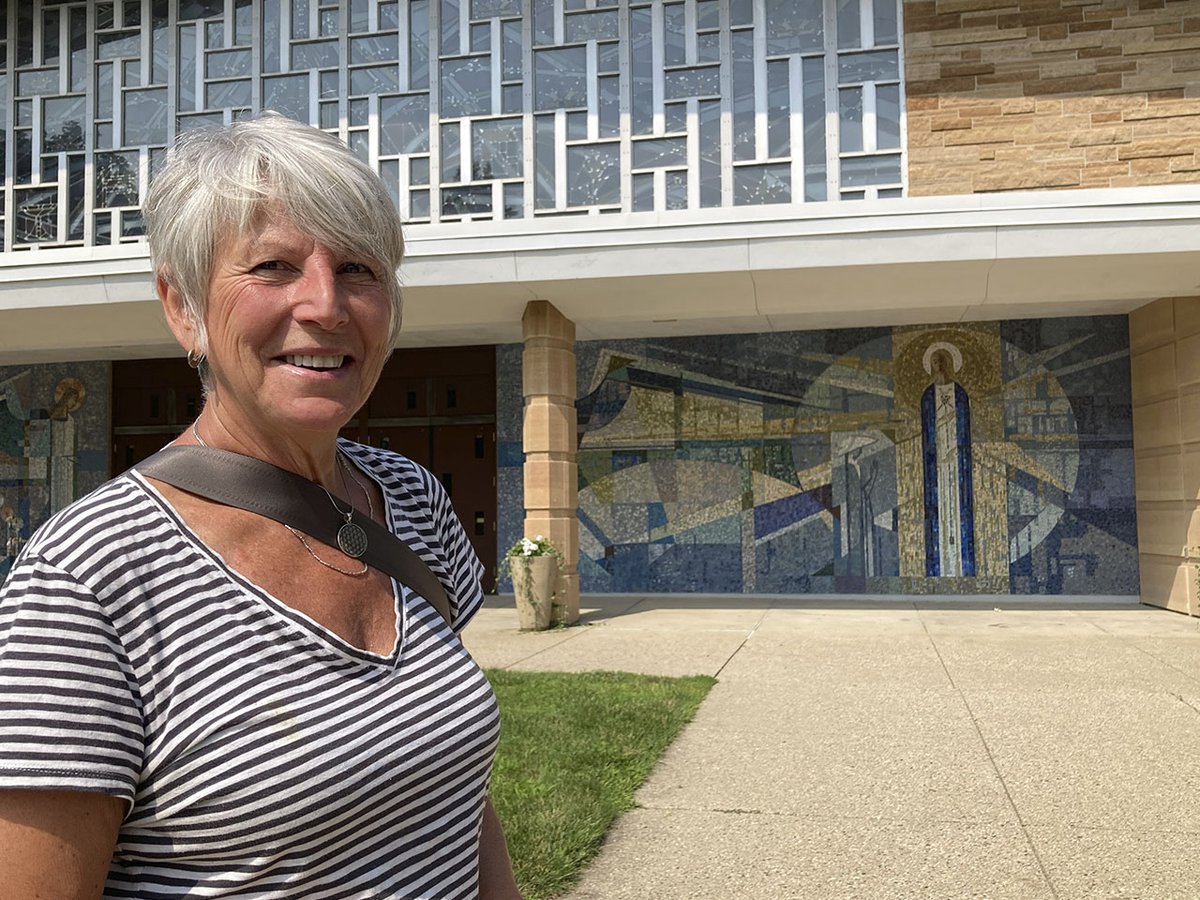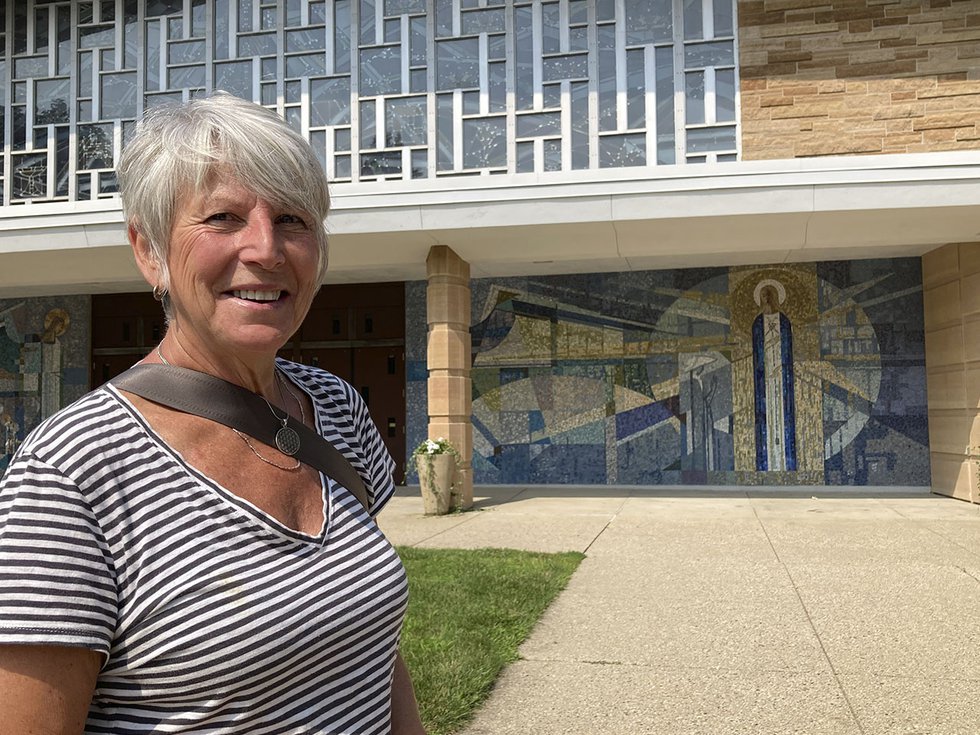Lillian Sizemore describes herself as a “mosaic detective.” As we meet to tour several sites included on her always-in-progress Google map, “Mosaics of Madison,” she boils it down further: “I’m a nerd,” she admits — not for the last time on this trip.
Sizemore shows me a handful of mosaic pieces called smalti — chunky little rectangles of opaque colored glass — as well as flatter, squarer ceramic tiles — both of which can be used in mosaics. “There’s no one way to make a mosaic,” says Sizemore. But for architectural murals, smalti is where it’s at. Smalti, a centuries-old material used only for mosaic, is made by hand, mostly in Italy. It’s the material used in mosaics around the world in the great cathedrals.
We start at Immaculate Heart of Mary church in Monona, what Sizemore calls a “swoonworthy” site. “This is one of the most beautiful applications of mid-century modern mosaics that I’ve seen,” she says, and mid-century is Sizemore’s special area of expertise. It was a time of great use of mosaics in civic, commercial and ecclesiastical architecture: “Architects wanted to incorporate art into architecture to add appeal to modernist buildings.” Another reason mosaics rose in popularity: soldiers returning from World War II after serving in Italy became interested in the form, having been exposed to Europe’s mosaics. Importing materials from Europe also became more affordable.
Immaculate Heart of Mary, completed in 1961, has a calm simplicity overall. Its blond woodwork and pews are plain, but its incorporation of mosaics throughout its design is opulent. The front exterior is decorated with two 25 x 11 foot murals, made with Italian glass smalti, flanking the entrance doors. The scene is of Mary appearing to a French nun, Justine Bisqueyburu, in 1840, a series of apparitions that birthed a Marian devotion known as the Green Scapular. Immaculate Heart of Mary was originally (and is again, as of last year) a Green Scapular shrine. A 20-foot tall, 12-ton statue of Mary in front of the church wears a glittering mosaic garment.
Inside, behind the altar is a “massive light-filled mosaic, made with a modern use of split-face white marble, green, blue and gold smalti,” writes Sizemore in her description for her map. Even the circular step risers to the altar are inlaid with mosaics. Ditto the holy water fonts.
All the mosaics at the church were made using the “indirect technique.” The design is mapped out, the smalti glued face down onto brown paper and the mural divided into numbered sections. The sections would be boxed and shipped from Germany, to be installed on the wall into mortar. Then the paper would be removed.
“Think pineapple upside-down cake!” Sizemore says of the process. The installation alone would have taken months.
De facto parish historian Kathy Marshall and summer intern Deacon Ryan Ruhle meet us at the church to share what Marshall has been able to find out about the history of the mosaics from the church archives — but details of its artistic inception are scant. After the Green Scapular shrine left the parish in 1968, “devotions went by the wayside,” says Marshall, and the meaning behind the mosaic faded.
On her own, however, The Mosaic Detective has already tracked down and contacted the Berlin, Germany, studio that created and fabricated the design. She’s arranged to visit the archive during a visit to Berlin this fall, and has received a copy of the numbered scheme for the layout of the altar mosaic (which shows a total of 532 sections) from the studio, as well as a photocopy of an original pencil sketch for the exterior mosaics.
The early sketch shows a different arrangement of figures in the mural, as well as text that didn’t make it into the final version.
“How did you find out all that?” Marshall asks, looking at the pencil sketch with amazement.
“This is what I do,” says Sizemore, explaining that she’d encountered the German studio’s work in other Wisconsin churches. “I live my life and [mosaics] come to me. It’s my passion.”
Sizemore’s passion for mosaics started modestly when she was living in Madison in the early 1990s. She was a production designer at The Guild (now CODAworx), the Madison-based e-commerce company that was the first to direct-market art online. She became “enthralled” with mosaic work submitted from artists around the country, while at the same time finding herself spending too much time on computer screens: “I needed to work with my hands again.” She found her way to a mosaic class in the basement of the WilMar Center taught by Laurel True, who made the Mother Fools Coffeehouse sign.
Sizemore moved to San Francisco in the mid-1990s and continued seeking out mosaics. She produced a pamphlet, “A Guide to Mosaic Sites – San Francisco” in 2004 featuring maps, photos and background on some 57 mosaics all over the city.
Ultimately she moved to England to study for a Ph.D. at the The Prince’s Foundation School of Traditional Arts in London, working on a translation of Italian futurist painter Gino Severini’s mosaic pedagogy. Her research has included the restoration of a 1956 film called The World of Mosaic, and she’s done extensive work uncovering the history of Pablo Picasso’s mostly overlooked mid-century mosaics.
She returned to Madison seven years ago because she had friends and family nearby: “It was a soft place to land.” In 2022 she created a labyrinth from discarded Christmas trees at Olbrich Park. She travels a good bit consulting and teaching, but she began mapping Madison’s mosaics much as she had San Francisco’s, with a Google map being a dynamic way to keep adding sites without reprinting a pamphlet.
“When I came back to Madison, I was surprised at how many more [mosaics] there were, and how much more I knew,” says Sizemore. There are currently 45 stops on the map, including civic institutions (the state Capitol dome, for instance, and mosaics by artist James Watrous on the UW-Madison campus), commercial locations (in the mid-20th century many businesses featured mosaic designs in their tile flooring and even included their business name mosaicked into their entranceway) and religious sites. Community projects (group creations often made with donated or broken material) and personal mosaics on private property are also included.
While Sizemore says Wisconsin has a “rich mosaic culture” in Milwaukee in Madison, that’s also not unusual. So do many other Midwestern cities. “You can find mosaics anywhere,” she says, and maybe that’s the real lesson.
Our tour continues in the Atwood neighborhood where there’s a cluster of commercial entranceway tilework, including in front of the Atwood Barbershop and the doorway to the Ohio Tavern. “It was an inexpensive way to show pride” in the business, says Sizemore. In the first half of the 20th century, many tilesetters had immigrated to the U.S. from Italy and new mass-produced tiles were affordable.
Across the street from The Ohio is a community mosaic project at the Dane County Juvenile Shelter. “Community mosaics are about community,” says Sizemore. “The point is, a bunch of kids worked together and made something to be proud of,” she says. But Sizemore warns that someone experienced with mosaics should be consulted on these projects so the art can live on into the future. Sometimes the substrate is improperly prepared, tiles are stuck on backwards (and thus more likely to detach) or the design makes the materials more vulnerable to Wisconsin’s freeze-thaw cycles.
Sizemore consulted on the community mosaic project “Narratives Build Knowledge” at the art space Communication, 2645 Milwaukee St. On our tour, Sizemore surveys the mosaic, made from donated and scrounged tiles, mounted on the front of the building in 2019. “It’s looking pretty good,” she says, dusting off a tile with her hand. “I might have to come back with a bucket and a rag.”
Vulnerability to the elements is not a problem only for community mosaics; Sizemore notes that the James Watrous 1973 sculptural mosaic work “Freedom of Communication” on the front of Vilas Hall on campus is missing smalti and its adhesive may be nearing the end of its usefulness.
Watrous’s extraordinary mid-century mosaics at Memorial Library, Social Sciences and Vilas and Ingraham Halls are not forgotten; Social Science’s “Man — Creator of Order and Disorder” was cleaned and restored in 2019. But they might be considered overlooked. Sizemore had a hard time finding anyone in Ingraham Hall who could even show her where the building’s “Ancient Commerce” and “Contemporary Commerce” mosaics are located. She found them on the basement level, outside the classroom B10 of the building once also known as Commerce.
“It’s part of human nature that we get used to our surroundings when we’re busy,” says Sizemore. When a mosaic goes out of style or is not “of the moment,” as Sizemore puts it, “it’s hard to get people to fix it or to see why it should be saved.” Often, she says, they get walled over in renovations. She’s currently working to save a tile mosaic in Milwaukee in a building about to be redeveloped. She’s also documenting 10 mosaic murals by UW-Madison professor emerita of art Marjorie Kreilick at the Milwaukee State Office Building, completed in 1963.
These days, Sizemore does more writing about mosaics than creating them. She thinks her dual role as a maker and an historian helps her in her role promoting mosaics: “I help people understand the value of what they have.”
We end our tour at the east-side home of Laurie Rossbach, who has transformed her yard with various art pieces in many mediums, including mosaics. A mosaicked wall, a woman’s head, a cat, and several fantastical towers populate the front yard. On one sculpture, a bust of a woman with flowing blue glass hair, Sizemore admires the careful cutting of the glass and how the pieces are placed to enhance the flow of the design, a technique called andamento. A fish, set into a wall, uses mother-of-pearl fragments, a clever touch.
“Start looking and seeing,” Sizemore advises. “Artists work hard to give us something nice to look at.”


